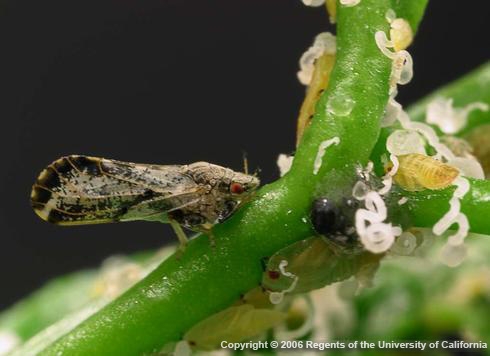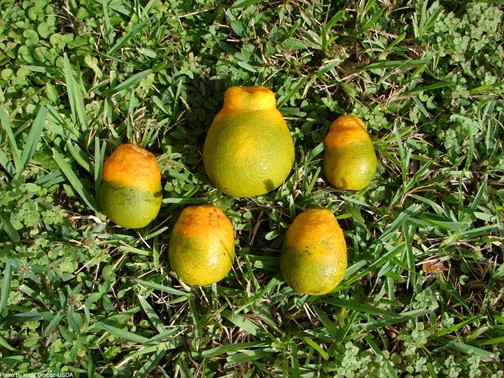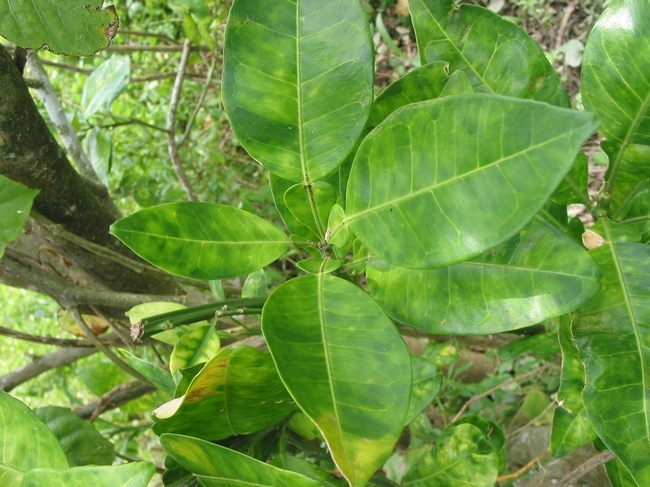Posts Tagged: HLB
Micronutrient deficiency can look like HLB infection
Familiarity with symptoms caused by micronutrient deficiencies is important for citrus growers and pest control advisers to ensure such maladies are not confused with symptoms of Huanglongbing, reported Cary Blake in Western Farm Press.
Neil O’Connell, UC Cooperative Extension advisor in Tulare County, a citrus expert, recommends that field staff also be well versed on these issues since they are in the field daily during the citrus harvest.
Huanglongbing, a disease spread by Asian citrus psyllid, is the worst citrus disease in the world. The disease was detected on one tree in Southern California in March, the first such find in the state. Officials are asking for farmers and home gardeners to be on the look-out for other HLB-infected trees.
O'Connell says deficiencies of zinc, iron and manganese can resemble leaf symptoms found in trees with HLB.
"Some deficiencies have fairly similar symptoms," O'Connell said. "If you are very familiar with deficiency patterns in these elements then it is much easier to separate this out. You can recognize whether the problem is zinc, iron, manganese, or another deficiency while possibly ruling out HLB."
A distinguishing characteristic of HLB infection is a yellow area that crosses from one interveinal area to another, O'Connell explained.
Citrus Greening
As a native Californian, I grew up enjoying California grown oranges, limes, lemons, and other common citrus. In fact as an adult, these fruits have become a staple of my diet. I try to purchase citrus at farmers markets and I check to see that it is grown in California not only to keep our agricultural sector strong, but because I think we have some of the best quality citrus in the world.
I have recently been educating myself on the latest serious pest related disease to affect Southern California citrus crops and I am starting to get worried that our illustrious citrus industry could be in for some trouble in the near future. The disease damaging Southern California crops is called Citrus Greening; its technical name is Huanglongbing (HLB). The disease is bacterial-based and is being spread by a tiny pest known as the Asian citrus psyllid. This problem seems to have origins in China and was first detected in the Florida citrus crops in the early 2000’s. It has finally made its way to California and that is cause for concern because there is no known cure for the disease, and it kills citrus trees as rapidly as within 5 years once they have become infected. The Florida crops have been under Federal quarantine since the discovery of the outbreak but in spite of that, the disease has emerged in our state recently. It seems to be centralized in the Southern California area and there are several local quarantine orders to prevent the spread of it in our direction here to the North, but that will only slow the spread, not completely contain it. Our central valley farmers have expressed legitimate concern over this disease because it has the potential to wipe out their livelihood. I urge all of us to honor and respect the quarantines on citrus and together we can do our part in keeping containment on Citrus Greening in the foreseeable future.

Asian citrus psyllid adults, yellow nymphs and white wax. (photo from UC IPM online)

Citrus greening damage. (photo by USDAgov)
Another attentive dog averts disaster
A FedEx package filled with curry leaves and guavas arrived in Sacramento Wednesday infested with 100 Asian citrus psyllids, the Los Angeles Times reported today. In a scenario eerily similar to one that took place in Fresno two weeks ago, a trained dog alerted authorities to the package, the pests were trapped, analyzed at a lab and determined to be free of the bacteria that causes the citrus disease Huanglongbing (HLB).The package destined for Fresno was mailed from India; the package in Sacramento came from Houston, Texas.
"We know that this has been going on but it is just now that we are getting a feeling for how bad it is as we get more federally funded dog teams out there," the article quoted Beth Grafton-Cardwell, a UC Riverside citrus entomologist based at the UC Lindcove Research and Extension Center in Exeter.
UC scientists are working with CDFA, USDA and the citrus industry to prevent establishment of Asian citrus psyllid in California. But the effort has been met with several recent setbacks. Their greatest fear is for the incurable HLB disease that the psyllid transmits.
Psyllids not infected with HLB were found in Imperial and San Diego counties early last year; this week isolated populations turned up Los Angeles and Orange county backyard citrus trees.
Grafton-Cardwell believes the pests' eventual spread through the state's citrus regions is inevitable.
"It's only a matter of time before the huanglongbing disease finds its way to California from Mexico or elsewhere," Grafton-Cardwell told LA Times reporter Jerry Hirsch.

White, waxy tubules are a tell-tale sign of Asian citrus psyllid.


